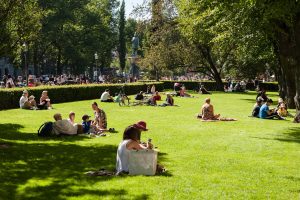Alueiden suojeluarvottaminen kaupunki- ja maakuntatason maankäytön suunnittelun tueksi
FM Joel Jalkasen Lectio praecursoria -puhe 27.11.2020

Arvoisa kustos, arvoisa vastaväittäjä, hyvät kuulijat
Me ihmiset aiheutamme toimillamme paraikaa massasukupuuttoa, joka uhkaa suurta osaa maailman elämästä. Tällä hetkellä selkeästi suurin uhka maapallon lajistolle on se, että ihmiskuntamme tuhoaa elinympäristöjä omien tarpeidensa alta.
Eri lähteistä toistuva viesti on selkeä ja kiistaton: tapamme käyttää maata on kestämätön.
Kuvaamani ongelma kilpistyy hyvin oheiseen kuvaan. Luonto esiintyy paikassa, ja samoin ihmisten intressit esimerkiksi ruuantuotantoon tai kaupunkien rakentamiseen kohdistuvat usein paikkaan. Siellä, missä toinen haluaisi perustaa luonnon puolesta suojelualueen, näkee toinen hyvän paikan uudelle asuinalueelle.
Tätä ristiriitaa ratkotaan maankäytön suunnittelulla. Siinä sovitellaan erilaisia paikkoihin kohdistuvia tarpeita ja intressejä ja tarkastellaan, miten niitä voidaan saavuttaa rajallisen fyysisen tilan puitteissa.



